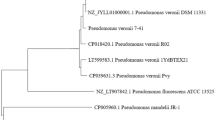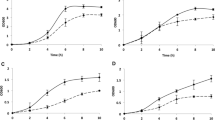Abstract
We inserted the E. coli lacZY genes into the chromosomes of Pseudomonas aeruginosa strains PAO-1 and PG-201 using a bicomponent transposition system, and obtained transconjugant strains with one set of lacZY genes integrated into the chromosomes at unique locations. The strains were positive in the o-nitrophenylgalacto-side (ONPG) test and produced E. coli β-galactosidase-related proteins in Western blots. The transconjugants grew well in lactose-based media (minimal medium and whey) albeit with reduced initial rates as compared to growth in glucose-based minimal media. Pseudomonas rhamnolipids were produced during stationary growth in lactose-based minimal media and whey, showing that waste products can be effectively used for important bio-technological processes.
This is a preview of subscription content, access via your institution
Access options
Subscribe to this journal
Receive 12 print issues and online access
$209.00 per year
only $17.42 per issue
Buy this article
- Purchase on Springer Link
- Instant access to full article PDF
Prices may be subject to local taxes which are calculated during checkout
Similar content being viewed by others
References
Hisatsuka, K., Nakahara, T., Sano, N., and Yamada, K. 1971. Formation of rhamnolipid by Pseudomonas aeruginosa and its function in hydrocarbon fermentation. Agric. Biol. Chem. 35:686–692.
Itoh, S., and Suzuki, T. 1972. Effect of rhamnolipids on growth of Pseudomonas aeruginosa mutant deficient in n-paraffin-utilizing ability. Agr. Biol. Chem. 36:2233–2235.
Itoh, S., Honda, H., Tomita, F., and Suzuki, T. 1971. Rhamnolipids produced by Pseudomonas aeruginosa grown on n-paraffin. The Journal of Antibiotics 24:855–859.
Edwards, J. and Hayashi, J. 1965. Structure of a rhamnolipid from Pseudomonas aeruginosa. Arch. Biochem. Biophys. 111:415–421.
Kosaric, N., Gray, N.C.C., and Cairns, W.L. 1983. Microbial emulsifiers and de-emulsifiers, p. 575–592. In: Biotechnology, vol. 3. Rehm, H. J. and Reed, G., (eds.) Verlag Chemie, Weinheim.
Finnerty, W.R., and Singer, M.E. 1983. Microbial enhancement of oil recovery. Bio/Technology 1:47–54.
Moulin, G. and Galzy, P. 1984. Whey, a potential substrate for biotechnology, p. 347–374. In: Biotechnology and Genetic Engineering Reviews 1. Russell, G. E. (ed.).
Drahos, D.J., Hemming, B.C., and McPherson, S. 1986. Tracking recombinant organisms in the environment: β-galactosidase as a selectable non-antibiotic marker for fluorescent pseudomonads. Bio/Technology 4:439–444.
Baumberg, S., Cornelis, G., Panagiotakopoulos, and Roberts, M. 1980. Expression of the lactose transposon Tn951 in Escherichia coli, Proteus and Pseudomonas. Journal of General Microbiology 119:257–262.
Barry, G.F. 1986. Permanent insertion of foreign genes into the chromosome of soil bacteria. Bio/Technology 4:446–449.
Holloway, B.W. 1969. Genetics of pseudomonads. Bacteriol. Rev. 33:419–433.
Guerra Santos, L.H., Käppeli, O., and Fiechter, A. 1986. Dependence of Pseudomonas aeruginosa continuous culture biosurfactant production on nutritional and environmental factors. Applied Microbiology and Biotechnology 24:443–448.
Ubben, D. and Schmitt, R. 1986. Tnl721 derivatives for transposon mutagenesis, restriction mapping and nucleotide sequence analysis. Gene 41:145–152.
Gray, M.R., Colot, H.V., Guarente, L., and Rosbash, M. 1982. Open reading frame cloning: identification, cloning, and expression of open reading frame DNA. Proc. Natl. Acad. Sci. USA 79:6598–6602.
Lichtenstein, C., and Brenner, S. 1981. Site-specific properties of Tn7 transposition into the E. coli chromosome. Mol. Gen. Genet. 183:380–387.
Boyer, H.W., and Roulland-Dussoix, D. 1969. A complementation analysis of the restriction and modification of DNA in Escherichia coli. J. Mol. Biol. 41:459–472.
Cornelis, G., Ghosal, D., and Saedler, H. 1978. Tn951: a new transposon carrying a lactose operon. Mol. Gen. Genet. 160:215–224.
Walsh, P.M., Haas, M.J., and Somkuti, G.A. 1984. Genetic construction of lactose-utilizing Xanthomonas campestris. Applied and Environ mental Microbiology 47:253–257.
Meselson, M. and Yuan, R. 1968. DNA restriction enzyme from E. coli. Nature 217:1110–1114.
Yanisch-Perron, C., Vieira, J., and Messing, J. 1985. Improved M13 phage cloning vectors and host strains: nucleotide sequences of the M13 mp18 and pUC19 vectors. Gene 33:103–119.
Maniatis, T., Fritsch, E.F., Sambrook, J. 1982. Molecular cloning-A laboratory manual. Cold Spring Harbor Laboratory, Cold Spring Harbor, New York.
Marmur, J. 1961. A procedure for the isolation of deoxyribonucleic acid from microorganisms. J. Mol. Biol. 3:208–218.
Feinberg, P., and Vogelstein, B. 1984. A technique for radiolabeling DNA restriction endonuclease fragments to high specific activity. Analytical Biochemistry 137:266–267.
Laemmli, U.K. 1970. Cleavage of structural proteins during the assembly of the head of the bacteriophage T4. Nature 227:680–685.
Towbin, H., Staehelin, T., and Gordon, J. 1979. Electrophoretic transfer of proteins from polyacrylamide gels to nitrocellulose sheets: Procedure and some applications. Proc. Natl. Acad. Sci. USA 76:4350–4354.
Johnson, D.A., Gautsch, J.W., Sportsman, J.R., and Elder, J.H. 1984. Improved technique utilizing nonfat dry milk for analysis of proteins and nucleic acids transferred to nitrocellulose. Gene Anal. Tech. 1:3–8.
Hawkes, R., Niday, E., and Gordon, J. 1982. A dot-immunobinding assay for monoclonal and other antibodies. Analytical Biochemistry 119:142–147.
Miller, J.H. 1972. Experiments in Molecular Genetics. Cold Spring Harbor Laboratory, Cold Spring Harbor, New York.
Christie, W.W. 1982. Lipid Analysis. 2nd Edition, Pereamon Press, p. 119–120.
Beutler, H.O. 1984. p. 104–112. In: Methods of Enzymatic Analysis, 3rd ed., Vol. 6. Bergmeyer, H. U. (ed.) Verlag Chemie, Weinheim, Deerfield Beach/Florida, Basel.
Author information
Authors and Affiliations
Rights and permissions
About this article
Cite this article
Koch, A., Reiser, J., Käppeli, O. et al. Genetic Construction of Lactose-Utilizing Strains of Pseudomonas Aeruginosa and Their Application in Biosurfactant Production. Nat Biotechnol 6, 1335–1339 (1988). https://doi.org/10.1038/nbt1188-1335
Received:
Accepted:
Issue Date:
DOI: https://doi.org/10.1038/nbt1188-1335
This article is cited by
-
Rhamnolipid synthesis and production with diverse resources
Frontiers of Chemical Science and Engineering (2017)
-
Biosurfactant production by microorganisms on unconventional carbon sources
Journal of Surfactants and Detergents (1999)
-
Utilization of molasses for biosurfactant production by two Bacillus strains at thermophilic conditions
Journal of the American Oil Chemists' Society (1997)
-
The use of agroindustrial by‐products for biosurfactant production
Journal of the American Oil Chemists' Society (1994)



